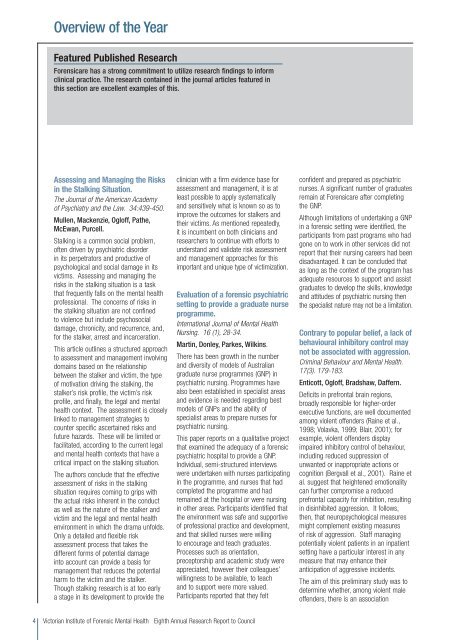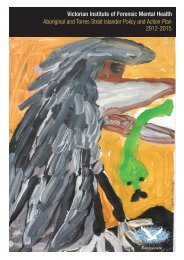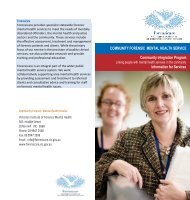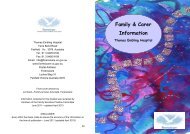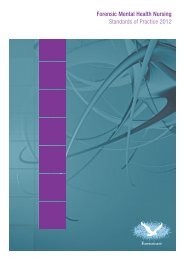Annual Research Report to Council 2006-2007 - Forensicare
Annual Research Report to Council 2006-2007 - Forensicare
Annual Research Report to Council 2006-2007 - Forensicare
- No tags were found...
Create successful ePaper yourself
Turn your PDF publications into a flip-book with our unique Google optimized e-Paper software.
Overview of the YearFeatured Published <strong>Research</strong><strong>Forensicare</strong> has a strong commitment <strong>to</strong> utilize research findings <strong>to</strong> informclinical practice. The research contained in the journal articles featured inthis section are excellent examples of this.Assessing and Managing the Risksin the Stalking Situation.The Journal of the American Academyof Psychiatry and the Law. 34:439-450.Mullen, Mackenzie, Ogloff, Pathe,McEwan, Purcell.Stalking is a common social problem,often driven by psychiatric disorderin its perpetra<strong>to</strong>rs and productive ofpsychological and social damage in itsvictims. Assessing and managing therisks in the stalking situation is a taskthat frequently falls on the mental healthprofessional. The concerns of risks inthe stalking situation are not confined<strong>to</strong> violence but include psychosocialdamage, chronicity, and recurrence, and,for the stalker, arrest and incarceration.This article outlines a structured approach<strong>to</strong> assessment and management involvingdomains based on the relationshipbetween the stalker and victim, the typeof motivation driving the stalking, thestalker’s risk profile, the victim’s riskprofile, and finally, the legal and mentalhealth context. The assessment is closelylinked <strong>to</strong> management strategies <strong>to</strong>counter specific ascertained risks andfuture hazards. These will be limited orfacilitated, according <strong>to</strong> the current legaland mental health contexts that have acritical impact on the stalking situation.The authors conclude that the effectiveassessment of risks in the stalkingsituation requires coming <strong>to</strong> grips withthe actual risks inherent in the conductas well as the nature of the stalker andvictim and the legal and mental healthenvironment in which the drama unfolds.Only a detailed and flexible riskassessment process that takes thedifferent forms of potential damagein<strong>to</strong> account can provide a basis formanagement that reduces the potentialharm <strong>to</strong> the victim and the stalker.Though stalking research is at <strong>to</strong>o earlya stage in its development <strong>to</strong> provide theclinician with a firm evidence base forassessment and management, it is atleast possible <strong>to</strong> apply systematicallyand sensitively what is known so as <strong>to</strong>improve the outcomes for stalkers andtheir victims. As mentioned repeatedly,it is incumbent on both clinicians andresearchers <strong>to</strong> continue with efforts <strong>to</strong>understand and validate risk assessmentand management approaches for thisimportant and unique type of victimization.Evaluation of a forensic psychiatricsetting <strong>to</strong> provide a graduate nurseprogramme.International Journal of Mental HealthNursing. 16 (1), 28-34.Martin, Donley, Parkes, Wilkins.There has been growth in the numberand diversity of models of Australiangraduate nurse programmes (GNP) inpsychiatric nursing. Programmes havealso been established in specialist areasand evidence is needed regarding bestmodels of GNPs and the ability ofspecialist areas <strong>to</strong> prepare nurses forpsychiatric nursing.This paper reports on a qualitative projectthat examined the adequacy of a forensicpsychiatric hospital <strong>to</strong> provide a GNP.Individual, semi-structured interviewswere undertaken with nurses participatingin the programme, and nurses that hadcompleted the programme and hadremained at the hospital or were nursingin other areas. Participants identified thatthe environment was safe and supportiveof professional practice and development,and that skilled nurses were willing<strong>to</strong> encourage and teach graduates.Processes such as orientation,precep<strong>to</strong>rship and academic study wereappreciated, however their colleagues’willingness <strong>to</strong> be available, <strong>to</strong> teachand <strong>to</strong> support were more valued.Participants reported that they feltconfident and prepared as psychiatricnurses. A significant number of graduatesremain at <strong>Forensicare</strong> after completingthe GNP.Although limitations of undertaking a GNPin a forensic setting were identified, theparticipants from past programs who hadgone on <strong>to</strong> work in other services did notreport that their nursing careers had beendisadvantaged. It can be concluded thatas long as the context of the program hasadequate resources <strong>to</strong> support and assistgraduates <strong>to</strong> develop the skills, knowledgeand attitudes of psychiatric nursing thenthe specialist nature may not be a limitation.Contrary <strong>to</strong> popular belief, a lack ofbehavioural inhibi<strong>to</strong>ry control maynot be associated with aggression.Criminal Behaviour and Mental Health.17(3). 179-183.Enticott, Ogloff, Bradshaw, Daffern.Deficits in prefrontal brain regions,broadly responsible for higher-orderexecutive functions, are well documentedamong violent offenders (Raine et al.,1998; Volavka, 1999; Blair, 2001); forexample, violent offenders displayimpaired inhibi<strong>to</strong>ry control of behaviour,including reduced suppression ofunwanted or inappropriate actions orcognition (Bergvall et al., 2001). Raine etal. suggest that heightened emotionalitycan further compromise a reducedprefrontal capacity for inhibition, resultingin disinhibited aggression. It follows,then, that neuropsychological measuresmight complement existing measuresof risk of aggression. Staff managingpotentially violent patients in an inpatientsetting have a particular interest in anymeasure that may enhance theiranticipation of aggressive incidents.The aim of this preliminary study was <strong>to</strong>determine whether, among violent maleoffenders, there is an association4 Vic<strong>to</strong>rian Institute of Forensic Mental Health Eighth <strong>Annual</strong> <strong>Research</strong> <strong>Report</strong> <strong>to</strong> <strong>Council</strong>


